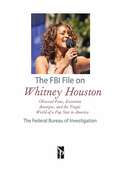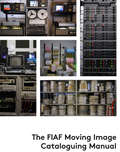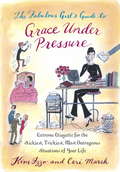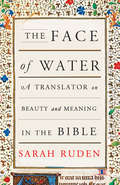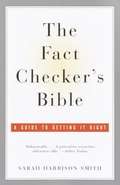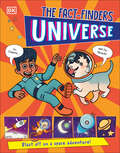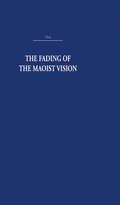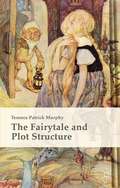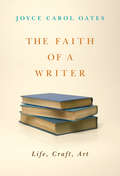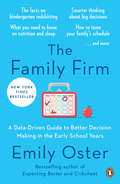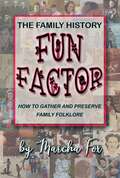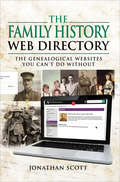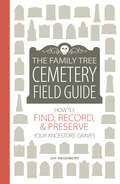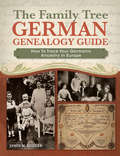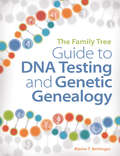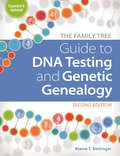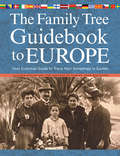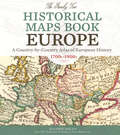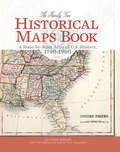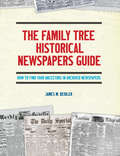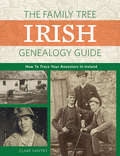- Table View
- List View
The F Word: A Fiancee Shares Her Story, From I Will To I Do
by Kelly Bare"Cancel your subscription to that bridal magazine! The F Word is the perfect marriage of personal insight and original advice you'll actually use." --Hilary Black, Editor in Chief, Tango Magazine "With humor and warmth, Kelly Bare's book helps couples bypass the pressures of planning a wedding without sacrificing the romance. --Susan Piver Author, The Hard Questions: 100 Essential Questions to Ask Before You Say "I Do." He Asked! You Said Yes! So. . .Now What? The moment you get engaged is one you'll never forget, as you begin your journey on an obstacle-free path to decades of wedded bliss. Right? Not necessarily. That one little question can spawn a one of big questions. Kelly Bare has been there. In The F Word, she shares first hand experiences of navigating the premarital minefield, providing reassuring and helpful information that will help you worry less about what a bride is supposed to be, and more about who you really are: How fighting can be good for youWhy everyone in your family--and his--is acting like a lunaticWhy etiquette truly is importantWhen--and how--to arrange a "meet the parents" get-togetherAlternatives to cringe-worthy bachelorette partiesThe real scoop on how to register for giftsHow to let go of perfection and plan a wedding that's really "you"Why marriage education classes could be the best investment you ever make Whether you're recently engaged, planning your wedding or preparing to take your relationship to a new level, The F Word will help you get from "I Will" to "I Do" with your relationship--and your sanity--intact. "A poignant, candid memoir. Brides-to-be will find a true friend here with Kelly Bare." --Rachel Greenwald, author of the New York Times Bestseller Find a Husband After 35 Using What I Learned at Harvard Business School." Kelly Bare is a writer and editor in New York City.
The FBI File on Whitney Houston
by The Federal Bureau of InvestigationReleased on March 6, 2013, The Whitney Houston FBI File contains dozens of letters from a crazed fan who just wanted to be noticed by the singer, details of an investigation into an extortion attempt at the height of Houston's career and threats from a Dutch fan claiming to be the "President of Europe." It is a terrifying and revealing look into the dizzying-and dangerous-life of a superstar.
The FIAF Moving Image Cataloguing Manual
by Linda TadicThe FIAF Moving Image Cataloguing Manual is the result of many years of labor and collaboration with numerous professionals in the moving image field. It addresses the changes in information technology that we’ve seen over the past two decades, and aligns with modern cataloguing and metadata standards and concepts such as FRBR (Functional Requirements for Bibliographic Records), EN 15907, and RDA (Resource Description and Access). The manual is designed to be compatible with a variety of data structures, and provides charts, decision trees, examples, and other tools to help experts and non-experts alike in performing real-world cataloguing of moving image collections.
The Fabulous Girl's Guide to Grace Under Pressure
by Kim Izzo Ceri MarshThe bestselling Fabulous Girl returns with more advice for the modern woman. Building on the enormous and continuing international success of their first book,The Fabulous Girl’s Guide to Decorum, Kim Izzo and Ceri Marsh are back with more invaluable advice on how to travel with grace over the rocky terrain of work, relationships, sex and friendship. Code Redis a modern woman’s survival guide to managing the often delicate and extreme moments of her sophisticated life. Witty and frank,Code Redoffers etiquette guidance on subjects relevant to the evolving Fabulous Girl, such as dating men with kids, ending affairs, surviving corporate mergers, changing careers mid-stream, or finding your husband in bed with another woman. In addition to the playful but frank advice Marsh and Izzo provide, they also reacquaint readers with the unforgettable Fabulous Girl, a character who vividly brings to life the etiquette lessons ofCode Red. A beautifully designed original trade paperback, with spot illustrations throughout,Code Redis a wonderful graduation and friendship gift, a valuable handbook, and an engaging read.
The Face of Water: A Translator on Beauty and Meaning in the Bible
by Sarah RudenA dazzling reconsideration of the original languages and texts of the Bible, in both the Old and the New Testaments, from the acclaimed scholar and translator of Classical literature (“The best translation of the Aeneid, certainly the best of our time” —Ursula Le Guin; “The first translation since Dryden that can be read as a great English poem in itself” —Garry Wills, The New York Review of Books) and author of Paul Among the People (“Astonishing . . . Superb” —Booklist, starred review). In The Face of Water, Sarah Ruden brilliantly and elegantly explains and celebrates the Bible’s writings. Singling out the most famous passages, such as the Genesis creation story, the Ten Commandments, the Lord’s Prayer, and the Beatitudes, Ruden reexamines and retranslates from the Hebrew and Greek what has been obscured and misunderstood over time. Making clear that she is not a Biblical scholar, cleric, theologian, or philosopher, Ruden—a Quaker—speaks plainly in this illuminating and inspiring book. She writes that while the Bible has always mattered profoundly, it is a book that in modern translations often lacks vitality, and she sets out here to make it less a thing of paper and glue and ink and more a live and loving text. Ruden writes of the early evolution, literary beauty, and transcendent ideals of the Hebrew Bible and the Greek New Testament, exploring how the Jews came to establish the greatest, most enduring book on earth as their regional strategic weakness found a paradoxical moral and spiritual strength through their writings, and how the Christians inherited and adapted this remarkable literary tradition. She writes as well about the crucial purposes of translation, not only for availability of texts but also for accountability in public life and as a reflection of society’s current concerns. She shows that it is the original texts that most clearly reveal our cherished values (both religious and secular), unlike the standard English translations of the Bible that mask even the yearning for freedom from slavery. The word “redemption” translated from Hebrew and Greek, meaning mercy for the exploited and oppressed, is more abstract than its original meaning—to buy a person back from captivity or slavery or some other distress. The Face of Water is as much a book about poetry, music, drama, raw humor, and passion as it is about the idealism of the Bible. Ruden’s book gives us an unprecedented, nuanced understanding of what this extraordinary document was for its earliest readers and what it can still be for us today
The Facility Management Handbook
by Kathy Roper Richard PayantThe wide-ranging umbrella of facility management covers everything from technology systems to disaster recover planning to zoning compliance…and that&’s just getting started.Facilities management is a multidisciplinary function that requires a deep knowledge of the entire business and physical planning cycle. Undoubtedly, the sheer scope of duties requires a far-reaching reference for staying abreast of the latest innovations and best practices. The Facility Management Handbook is the answer.This guide shares insightful overviews, case studies, and practical guidelines that pave the way for successful planning, budgeting, real estate transactions, construction, emergency preparedness, security, operations, maintenance, and more.The thoroughly revised fourth edition examines cutting-edge technologies and includes new information on:Building Information Modeling (BIM)Contracting and project management methodsFASB and IASB requirementsDistributed workingSustainability reporting and moreThe Facility Management Handbook is the one-stop resource every facility manager must have to master a broad scope of duties while staying current on innovations and best practices.
The Fact Checker's Bible: A Guide to Getting It Right
by Sarah Harrison SmithThe first book of its kind,The Fact Checker’s Bibleis the essential guide to the important but often neglected task of checking facts, whatever their source. Today, everyone is overwhelmed with information that claims to be factual. But even the most punctilious researcher, writer, student or journalist--not to mention the lazy or deliberately mendacious ones--can sometimes get it wrong. So checking facts has become a more pressing task. But how to go about it? The Fact Checker’s Biblecovers: *Reading for accuracy *Determining what to check *Researching the facts *Assessing sources: people, newspapers and magazines, books, the Internet, etc. *Checking quotations *Understanding the legal liabilities of getting it wrong *Looking out for and avoiding the dangers of plagiarism For everyone from students to editors to journalists, the methods and practices outlined inThe Fact Checker’s Bibleprovides both a standard and a working manual for how to get the facts right. From the Trade Paperback edition.
The Fact-Finders Ocean: Discover the Secrets of the Deep! (The Fact-Finders)
by DKExplore the wonderful world beneath the waves in this fun, non-fiction graphic novel packed with fun facts and engaging characters.Learn about waves, tides, and currents, which keep our oceans moving continuously in this comic book for children aged 6-8. Filled with bite-sized information, colorful illustrations, and a fun story, this graphic novel will engage every budding marine enthusiast and nature explorer. With the help of the Fact-Finders, children will stock up on their knowledge as well as understand the importance of the ocean and how crucial it is to protect it.This educational graphic novel for kids offers: Age-appropriate vocabulary that explains a wide range of both familiar and unfamiliar topics and terms.Fun and engaging characters and facts provided in in a conversational style for an immersive learning experience.Content by award-winning author Tracey Turner which has been checked by experts to ensure all information is credible. Put on your wetsuit, jump into the ocean, and swim along to explore with your guides, Shelly and Bubbles. Learn all about the world's oceans, underwater habitats, and the fascinating lives of countless creatures that live there. What lurks in the ocean's darkest depths? Where can you find gummy squirrels and yeti crabs? Why are cookie cutters and chocolate chips part of marine life? Find out all this and much more in this guide to our underwater world!More in the seriesFact-Finders is a fun, nonfiction graphic novel series that teaches kids all about a variety of topics on the world around them. If you enjoyed Fact-Finders Ocean, why not try Fact-Finders Universe to discover our vast solar system and beyond?
The Fact-Finders Universe: Blast Off on a Space Adventure! (The Fact-Finders)
by DKExplore the wonders of the Universe in this fun, non-fiction graphic novel packed with fun facts and engaging characters.Learn about the Asteroid and Kuiper Belts, which exist between planets and even contain objects, in this comic book for children aged 6-8.Filled with bite-sized information, colorful illustrations, and a fun story, this graphic novel will engage every budding science enthusiast and space explorer. With the help of the Fact-Finders, children will stock up on their space knowledge and will understand our place in the solar system.This educational graphic novel for kids offers: Age-appropriate vocabulary that explains a wide range of both familiar and unfamiliar topics and terms.Fun and engaging characters and facts provided in in a conversational style for an immersive learning experience.Content by award-winning author Tracey Turner which has been checked by experts to ensure all information is credible.Grab your space suit, hop on board the Interstellar Sausage, and zoom into space with space experts Cosmo and Quark. Find out all about asteroids, shooting stars, black holes, and the real-life astronauts who explore our solar system.Why do we have seasons and moon phases? Is there weather on other planets? Which animals have had a chance to explore space? Find out all this and much more in this guide to the Universe beyond Earth!More in the seriesFact-Finders is a fun, non-fiction graphic novel series that teaches kids all about a variety of topics on the world around them. If you enjoyed Fact-Finders Universe, why not try Fact-Finders Ocean to discover what goes on beneath the waves?
The Fading of the Maoist Vision: City and Country in China's Development
by Rhoads MurpheyFirst published in 1980.This book analyzes Chinese society and evaluates the achievements and failures of the Maoist ideology. The central theme is the urban and rural balance in China's development from the Revolution to the late twentieth century. The Fading of the Maoist Vision shows how the original Revolutionary blueprint was altered and the ways in which China has steered a different course from that charted by Mao as the ideological vision encountered an increasingly pressing set of economic realities. The book: · Is particularly valuable in setting China's achievements in the larger context of global ideas about the problems of national development and by comparing them to the experience of India in its pursuit of the Gandhian ideal.
The Faith of a Writer: Life, Craft, Art
by Joyce Carol OatesA tribute to the brilliant craftsmanship of one of our most distinguished writers, providing valuable insight into her inspiration and her method Joyce Carol Oates is widely regarded as one of America's greatest contemporary literary figures. Having written in a number of genres -- prose, poetry, personal and critical essays, as well as plays -- she is an artist ideally suited to answer essential questions about what makes a story striking, a novel come alive, a writer an artist as well as a craftsman. In The Faith of a Writer, Oates discusses the subjects most important to the narrative craft, touching on topics such as inspiration, memory, self-criticism, and "the unique power of the unconscious." On a more personal note, she speaks of childhood inspirations, offers advice to young writers, and discusses the wildly varying states of mind of a writer at work. Oates also pays homage to those she calls her "significant predecessors" and discusses the importance of reading in the life of a writer. Oates claims, "Inspiration and energy and even genius are rarely enough to make 'art': for prose fiction is also a craft, and craft must be learned, whether by accident or design." In fourteen succinct chapters, The Faith of a Writer provides valuable lessons on how language, ideas, and experience are assembled to create art.
The Family Firm: A Data-Driven Guide to Better Decision Making in the Early School Years (The ParentData Series #3)
by Emily OsterFrom the bestselling author of Expecting Better and Cribsheet, the next step in data driven parenting from economist Emily Oster.Parenting is a full-time job. It's time we start treating it like one.&“Emily Oster dives into the data on parenting issues, cuts through the clutter, and gives families the bottom line to help them make better decisions. Her books on pregnancy and toddlers skyrocketed her to parenting-world fame, and now she&’s back, crunching the numbers on topics that keep parents with school-age kids up at night.&” –Good Morning America&“A targeted mini-MBA program designed to help moms and dads establish best practices for day-to-day operations...It&’s all presented in the breezy, skeptical style that&’s made Oster&’s work a must-read for parents." -The Washington PostIn The Family Firm, Brown professor of economics and mom of two Emily Oster offers a classic business school framework for data-driven parents to think more deliberately about the key issues of the elementary years: school, health, extracurricular activities, and more.Unlike the hourly challenges of infant parenting, the big questions in this age come up less frequently. But we live with the consequences of our decisions for much longer. What's the right kind of school and at what age should a particular kid start? How do you encourage a healthy diet? Should kids play a sport and how seriously? How do you think smartly about encouraging children's independence? Along with these bigger questions, Oster investigates how to navigate the complexity of day-to-day family logistics.Making these decisions is less about finding the specific answer and more about taking the right approach. Parents of this age are often still working in baby mode, which is to say, under stress and on the fly. That is a classic management problem, and Oster takes a page from her time as a business school professor at the University of Chicago to show us that thoughtful business process can help smooth out tough family decisions.The Family Firm is a smart and winning guide to how to think clearly--and with less ambient stress--about the key decisions of the elementary school years.
The Family History Fun Factor: How to Gather and Preserve Family Folklore
by Marcha FoxAs a genealogist, what would you give to spend one day with one of your ancestors? To witness everyday details of his or her life, whether it involved a favorite recipe, cooking methods, gardening, transportation or how children spent their day? <p><p>Genealogy and stories related to major life events are often found in journals and other sources, but what about activities such as holiday celebrations or games children played on balmy summer evenings? Wouldn't you like to go one step beyond vague stories about walking four miles to school through two feet of snow or canning peaches on a woodstove? On a more recent level, what are your favorite memories about growing up? Did you carry on the same holiday traditions as an adult? Where and when did they originate? Generations ago? Or more recently? <p><p>Which begs the question, what will your progeny know about your daily life? Where do you even begin to record, much less organize, such things? What do you even call it? It's not genealogy, not family history--so what is it? All these delightful details about everyday life are what comprise family folklore! And if you want to learn how to preserve these precious family memories, The Family History Fun Factor tells you exactly how. You'll learn which genres are included, see examples, even find a checklist and resource list. <p><p>If you've procrastinated writing your personal history (and who hasn't?) this is the perfect place to start! No research is required, it's all inside your head. Just recall those everyday activities that make life worth living. Wait until the next holiday, if you like, then record what you do in the Family Folklore Idea Collection Sheet in the appendix. <p><p>Easy, peasy. <p><p>Subsequent generations will thank you for it.
The Family History Web Directory: The Genealogical Websites You Can't Do Without
by Jonathan ScottJonathan Scott's Family History Web Directory is an information-packed reference guide that distils the best of the internet into one easy-to-use format. Themed sections cover different topics, from 'getting started' to specific occupations, and there is an index reproducing all the websites in A-Z order. His handbook is a vital source for less experienced researchers, and a handy aide-memoire for more seasoned campaigners. Web addresses are listed by topic, then in order of importance and usefulness. An extraordinary range of sites that will interest family historians is included from records of births and deaths, tax, crime and religion, to military records and records of work and occupations. Also featured are sites that give information about archives, blogs and forums, social networking and sharing research.The internet can be an overwhelming place for the genealogist. Jonathan Scott's book provides readers with online shortcuts, tips for getting the best from well-known websites, plus the details of all kinds of lesser-known and hard-to-find sources.
The Family Tree Cemetery Field Guide: How to Find, Record, and Preserve Your Ancestor's Grave
by Joy NeighborsNot all research can be done from home--sometimes you have to head into the field. Cemeteries are crucial for any genealogist's search, and this book will show you how to search for and analyze your ancestors' graves. Discover tools for locating tombstones, tips for traipsing through cemeteries, an at-a-glance guide to frequently used gravestone icons, and practical strategies for on-the-ground research. And once you've returned home, learn how to incorporate gravestone information into your research, as well as how to upload grave locations to BillionGraves and record your findings in memorial pages on Find A Grave.Detailed step-by-step guides to finding ancestors' cemeteries using websites like Find A Grave, plus how to record and preserve death and burial informationTips and strategies for navigating cemeteries and finding individual tombstones in the field, plus an at-a-glance guide to tombstone symbols and iconographyResources and techniques for discovering other death records and incorporating information from cemeteries into genealogical research
The Family Tree German Genealogy Guide: How to Trace Your Germanic Ancestry in Europe
by James BeidlerExplore Your German Ancestry! Follow your family tree back to its roots in Bavaria, Baden, Prussia, Hesse, Saxony, Wurttemburg and beyond. This in-depth genealogy guide will walk you step by step through the exciting journey of researching your German heritage, whether your ancestors came from lands now in modern-day Germany or other German-speaking areas of Europe, including Austria, Switzerland, and enclaves across Eastern Europe. In this book, you'll learn how to: Retrace your German immigrant ancestors' voyage from Europe to America. Pinpoint the precise place in Europe your ancestors came from. Uncover birth, marriage, death, church, census, court, military, and other records documenting your ancestors' lives. Access German records of your family from your own hometown. Decipher German-language records, including unfamiliar German script. Understand German names and naming patterns that offer research clues. You'll also find maps, timelines, sample records and resource lists throughout the book for quick and easy reference. Whether you're just beginning your family tree or a longtime genealogy researcher, the Family Tree German Genealogy Guide will help you conquer the unique challenges of German research and uncover your ancestors' stories.
The Family Tree Guide to DNA Testing and Genetic Genealogy
by Blaine BettingerUnlock the secrets in your DNA! Discover the answers to your family history mysteries using the most-cutting edge tool available. This plain-English guide is a one-stop resource for how to use DNA testing for genealogy. Inside, you'll find guidance on what DNA tests are available, plus the methodologies and pros and cons of the three major testing companies and advice on choosing the right test to answer your specific genealogy questions. And once you've taken a DNA test, this guide will demystify the often-overwhelming subject and explain how to interpret DNA test results, including how to understand ethnicity estimates and haplogroup designations, navigate suggested cousin matches, and use third-party tools like GEDmatch to further analyze your data. To give you a holistic view of genetic testing for ancestry, the book also discusses the ethics and future of genetic genealogy, as well as how adoptees and others who know little about their ancestry can especially benefit from DNA testing. The book features:Colorful diagrams and expert definitions that explain key DNA terms and concepts such as haplogroups and DNA inheritance patternsDetailed guides to each of the major kinds of DNA tests and which tests can solve which family mysteries, with case studies showing how each can be usefulInformation about third-party tools you can use to more thoroughly analyze your test results once you've received themTest comparison guides and research forms to help you select the most appropriate DNA test and organize your results and research once you've been testedWhether you've just heard of DNA testing or you've tested at all three major companies, this guide will give you the tools you need to unpuzzle your DNA and discover what it can tell you about your family tree.
The Family Tree Guide to DNA Testing and Genetic Genealogy
by Blaine BettingerDiscover the answers to your family history mysteries using the most-cutting edge tool available to genealogists. This plain-English guide, newly revised and expanded, is a one-stop resource on genetic genealogy for family historians. Inside, you’ll learn what DNA tests are available, with up-to-date pros and cons of the major testing companies (including AncestryDNA) and advice on choosing the right test to answer your specific questions. For those who've already taken DNA tests, this guide will demystify and explain how to interpret DNA test results, including how to understand ethnicity estimates and haplogroup designations, navigate suggested cousin matches, and use third-party tools like GEDmatch to further analyze data. Inside, you'll find:Colorful diagrams and expert definitions that explain key DNA terms and concepts, such as haplogroups and DNA inheritance patternsDetailed guides to each of the major kinds of DNA tests: autosomal-DNA (atDNA), mitochondrial-DNA (mtDNA), Y-chromosomal DNA (Y-DNA), and X-chromosomal DNA (X-DNA)Tips for selecting the DNA test that can best help solve your family mysteries, with case studies showing how each test can be useful in researchInformation about third-party tools you can use to more thoroughly analyze your test results once you've received themTest companion guides and research forms to help you select the most appropriate DNA test and organize your results and research once you've been tested
The Family Tree Guidebook to Europe: Your Essential Guide to Trace Your Genealogy in Europ
by Allison DolanYour passport to European research! Chart your research course to find your European ancestors with the beginner-friendly, how-to instruction in this book. This one-of-a-kind collection provides invaluable information about more than 35 countries in a single source. Each of the 14 chapters is devoted to a specific country or region of Europe and includes all the essential records and resources for filling in your family tree. Inside you'll find: Specific online and print resources including 700 websites. Contact information for more than 100 archives and libraries. Help finding relevant records. Traditions and historical events that may affect your family's past. Historical time lines and maps for each region and country. Tracing your European ancestors can be a challenging voyage. This book will start you on the right path to identifying your roots and following your ancestors' winding journey through history.
The Family Tree Historical Atlas of Germany
by James BeidlerDelve into German history with beautiful historical maps and useful, comprehensive timelines. This book will help you untangle the complicated mess that is German history, tracing how state boundaries have changed throughout the centuries. With 100-plus full-color maps, this gorgeous atlas will guide you from the region's earliest days to the Holy Roman Empire and from Unification (1871) to Reunification (1990). The book also provides detailed summaries of major events in German history, giving you the tools you need to find records in various time periods. Inside, you'll find:Curated maps of German states from medieval times to present, each with detailed captions to explain what the map depicts and why it can be useful in researchExtensive histories of Germanic regions to walk you through the country's complex pastBeautiful, full-color maps bound in a hardcover format that makes a great gift for historians and genealogists
The Family Tree Historical Maps Book - Europe: A Country-by-Country Atlas of European History, 1700s-1900s
by Allison Dolan Family Tree Magazine EditorsJourney to the Old Country From Ireland to Italy, Portugal to Poland, Germany to Greece, and everywhere in between, explore your ancestors' European homelands through more than 200 gorgeous reproductions of 18th-century maps, 19th-century and early 20th-century maps. These full-color period maps--covering the peak years of European immigration to America--will help you understand changing boundaries in ancestral countries, and inform your search for genealogical records. Inside you'll find: Historical maps of the European continent showing how national borders evolved over three centuries Detailed country maps illustrating key geographical units--provinces, counties, regions, cities and more Time lines of important events in each country's history Lists of administrative divisions by country for easy reference A complete index to aid in viewing maps of interest in greater detail online This country-by-country atlas is an indispensable tool for European genealogy. Put your ancestral origins in geographical context, unravel the boundary changes that trip up genealogists, and envision the old country as your ancestors knew it. The book is also a valuable reference for teachers, homeschooling parents and anyone with an interest in European history. Time travel across the continent with the Family Tree Historical Maps Book: Europe.
The Family Tree Historical Maps Book: A State-by-State Atlas of US History, 1790-1900
by Allison Dolan Family Tree Magazine EditorsJourney Into the Past! Envision your ancestors' world--as your ancestors knew it--through hundreds of beautiful full-color reproductions of useful eighteenth and nineteenth century maps. The maps illustrate the historical boundaries of each of the U.S. states as they progressed from territories to statehood and show the shifting of county boundaries and names within states over the years. Inside you'll find: Full-color historical maps of the United States from each decade of the nineteenth century. Detailed, full-color historical maps of all 50 U.S. states. Time lines of significant events in each state's history. Charming nineteenth-century panoramic maps of key cities. Special-interest maps, which provide intriguing peeks into American society from average family sizes to taxation per capita to regional industries. This book is perfect for family historians researching their American roots. The maps can help you: put research in geographical context; identify jurisdictions that likely hold your ancestors' records; note the potential locations of "missing" records; track and visualize migrations; and understand the evolution of national, state and county borders. The maps also provide great historical context for students, teachers, homeschooling parents and anyone with an interest in U.S. history. Bring American history to life with this ultimate collection of vintage maps.
The Family Tree Historical Newspapers Guide: How to Find Your Ancestors in Archived Newspapers
by James BeidlerThere are more historical newspaper resources than you think--and they're easier to access than you know. When researched properly, no other type of record can beat historical newspapers in "taking the pulse" of their times and places, recording not just the names, but also information important to the community. This comprehensive how-to guide will show you how to harvest the "social media" of centuries past to learn about your ancestors and the times and places they lived in. With step-by-step examples, case studies, templates, worksheets, and screenshots, this book shows you what you can find in online (and offline) historical newspapers, from city dailies to weekly community papers to foreign-language gazetteers.The Family Tree Historical Newspapers Guide features:Tips and techniques for finding crucial genealogy records in newspapers, such as birth announcements, obituaries, and even news reportsStep-by-step guides for using popular online newspaper databases such as GenealogyBank and Newspapers.comCase studies that will put information found in newspapers to use
The Family Tree Irish Genealogy Guide: How to Trace Your Ancestors in Ireland
by Claire SantryDiscover your Irish roots! Trace your Irish ancestors from American shores back to the Emerald Isle. This in-depth guide from Irish genealogy expert Claire Santry will take you step-by-step through the exciting--and challenging--journey of discovering your Irish roots. You'll learn how to identify immigrant ancestor, find your family's county and townland of origin, and locate key genealogical resources that will breathe life into your family tree. With historical timelines, sample records, resource lists, and detailed information about where and how to find your ancestors online, this guide has everything you need to uncover your Irish heritage.In this book, you'll find:The best online resources for Irish genealogyDetailed guidance for finding records in the old country, from both the Republic of Ireland and Northern IrelandHelpful background on Irish history, geography, administrative divisions, and naming patternsCase studies that apply concepts and strategies to real-life research problemsWhether your ancestors hail from the bustling streets of Dublin or a small town in County Cork, The Family Tree Irish Genealogy Guide will give you the tools you need to track down your ancestors in Ireland.

